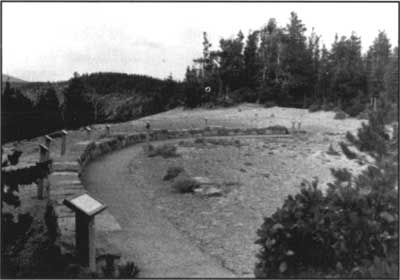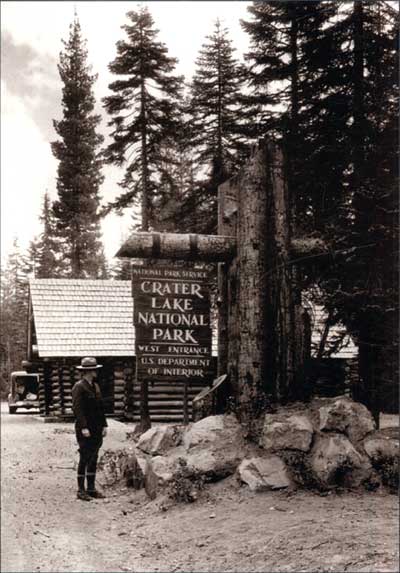With those criteria in mind, my choice is a place known as Victor View. It does not appear on some maps, though the name became official in 1945. The park superintendent at that time found very few people who could identify the rock named for Mrs. Victor, even though thousands of visitors came to the Sinnott Memorial each summer. Victor View is an observation station located between Cloud Cap and Kerr Notch, but has not been signed as such. Neither is the trail which leads from pavement to Sentinel Rock, where people who are afraid of heights or inclined toward vertigo should not venture. A stand of mountain hemlock (Tsuga mertensiana) act as a screen so that many visitors stopping at the road overlook do not notice the trail, but it can be seen immediately opposite the masonry wall. After winding through the trees, this path emerges on a spine composed largely of pumice “gravel” so that it is roughly a hundred yards to the terminus at Sentinel Rock.

Grotto Cove Overlook in 1968. NPS photo by K.R. Cranson
Such a vantage point certainly fills the few human visitors it receives with a sense of how privileged they are to stand where only the birds seem to light. A number of other places around the rim (Dutton Cliff, Dyar Rock, Hillman Peak, to name a few) may equal Victor View depending on what a person wishes to experience in conjunction with Crater Lake. Judgments attached to any of these places are, of course, relative to the person involved but any of them can render the urgency of reaching other destinations outside the park meaningless for a couple of hours. It should come as no surprise. therefore, that if I have to respond to questions about the “best” place to see Crater Lake, the answer will be “as far from your car as possible.”
Steve Mark has worked as park historian at Crater Lake and Oregon Caves since 1988.

Superintendent Dave Canfield and a new entrance sign, 1936. NPS photo by George Grant.

